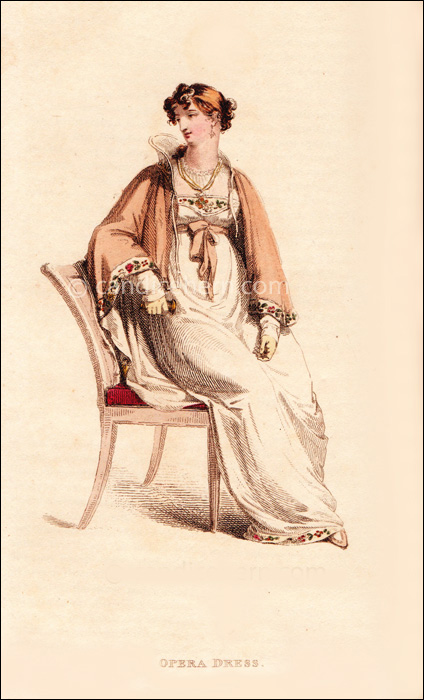Grace attends the theater with Rochdale, wearing an opera dress edged in bright-colored embroidery, and a cloak with a high-standing collar.

Ackermann’s Repository of Arts, February 1813.
“Opera Dress”
 Whereas the magazines’ texts accompanying prints of day wear tend to spend a lot of time describing the bonnet, those for prints showing evening wear often describe the hairdo in detail, as here. So, not only do the magazines provide enough information on the dresses to aid the dressmaker, or milliner, they also give a lady or her lady’s maid information on how to dress the hair in the latest styles.
Whereas the magazines’ texts accompanying prints of day wear tend to spend a lot of time describing the bonnet, those for prints showing evening wear often describe the hairdo in detail, as here. So, not only do the magazines provide enough information on the dresses to aid the dressmaker, or milliner, they also give a lady or her lady’s maid information on how to dress the hair in the latest styles.The print is described in the magazine as follows:
“A round robe of mull muslin, or crape, over satin or sarsnet, with long sleeve and low front, bordered at the bottom and on the bosom with a rich brocade ribband, or embroidery of coloured silks. A patent net neckerchief, edged with lace round the throat. A sash of pale Russian flame colour, tied negligently in front of the waist. The hair flat on the sides and in waved curls in front, divided in the center of the forehead, and confined in full curls at the back of the head, with an apparent stray ringlet falling over one shoulder. Neck-chain, ear-rings, and cross, of blended gold and pearl. A Cossack cloak, or mantle, or pale Russian flame-coloured cloth, with arched standing collar, finished with a coloured border, corresponding with the dress; lined with whte sarnet, and confined occasionally at the throat with a corresponding cord and tassel. Satin slippers, the colour of the mantle; and glove, a pale primrose.”





